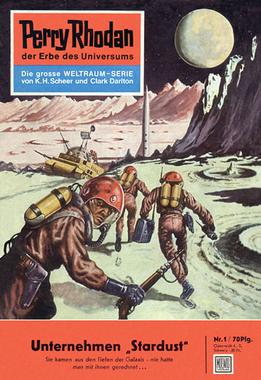Related Research Articles

Surveyor 5 is the fifth lunar lander of the American uncrewed Surveyor program sent to explore the surface of the Moon. Surveyor 5 landed on Mare Tranquillitatis in 1967. A total of 19,118 images were transmitted to Earth.

The Voyager Golden Records are two identical phonograph records which were included aboard the two Voyager spacecraft launched in 1977. The records contain sounds and images selected to portray the diversity of life and culture on Earth, and are intended for any intelligent extraterrestrial life form who may find them. The records are a time capsule.

Cosmos: A Personal Voyage is a thirteen-part, 1980–81 television series written by Carl Sagan, Ann Druyan, and Steven Soter, with Sagan as presenter. It was executive-produced by Adrian Malone, produced by David Kennard, Geoffrey Haines-Stiles, and Gregory Andorfer, and directed by the producers, David Oyster, Richard Wells, Tom Weidlinger, and others. It covers a wide range of scientific subjects, including the origin of life and a perspective of our place in the universe. Owing to its bestselling companion book and soundtrack album using the title, Cosmos, the series is widely known by this title, with the subtitle omitted from home video packaging. The subtitle began to be used more frequently in the 2010s to differentiate it from the sequel series that followed.

Journey Into Space is a BBC Radio science fiction programme written by BBC producer Charles Chilton. It was the last UK radio programme to attract a bigger evening audience than television. Originally, four series were produced, which was translated into 17 languages and broadcast in countries worldwide. Chilton later wrote three best-selling novels and several comic strip stories based upon the radio series.

Perry Rhodan is a German space opera franchise, named after its hero. It commenced in 1961 and has been ongoing for decades, written by an ever-changing team of authors. Having sold approximately two billion copies worldwide, it is the most successful science fiction book series ever written. The first billion of worldwide sales was celebrated in 1986. The series has spun off into comic books, audio dramas, video games and the like. A reboot, Perry Rhodan NEO, was launched in 2011 and began publication in English in April 2021.

"The Best of Both Worlds" is the 26th episode of the third season and the first episode of the fourth season of the American science fiction television series Star Trek: The Next Generation. It comprises the 74th and 75th episodes of the series overall. The first part was originally aired on June 18, 1990, and the second on September 24, 1990 in broadcast syndication television.

ARD is a joint organisation of Germany's regional public-service broadcasters. It was founded in 1950 in West Germany to represent the common interests of the new, decentralised, post-war broadcasting services – in particular the introduction of a joint television network.
Christopher Franke is a German musician and composer. From 1971 to 1987, he was a member of the electronic group Tangerine Dream. Initially a drummer with The Agitation, later renamed Agitation Free, his primary focus eventually shifted to keyboards and synthesizers as the group moved away from its psychedelic rock origins. While he was not the first musician to use an analog sequencer, he was probably the first to turn it into a live performance instrument, thus laying the rhythmic foundation for classic Tangerine Dream pieces and indeed for the whole Berlin school sound.

Jesco Hans Heinrich Max Freiherr von Puttkamer was a German-American aerospace engineer, senior manager at NASA, and a pulp science fiction writer.

Bayerischer Rundfunk, shortened to BR, is a public-service radio and television broadcaster, based in Munich, capital city of the Free State of Bavaria in Germany. BR is a member organization of the ARD consortium of public broadcasters in Germany.

On Christmas Eve, December 24, 1968, the crew of Apollo 8, the first humans to travel to the Moon, read from the Book of Genesis during a television broadcast. During their ninth orbit of the Moon astronauts Bill Anders, Jim Lovell, and Frank Borman recited verses 1 through 10 of the Genesis creation narrative from the King James Bible. Anders read verses 1–4, Lovell verses 5–8, and Borman read verses 9 and 10.

KINK is a commercial radio station in Portland, Oregon. It is owned by Alpha Media and it airs an adult album alternative radio format. KINK's studios and offices are on Southwest 5th Avenue in the PacWest Center. The signal is heard over much of Northwest Oregon and Southwest Washington. The transmitter is located off Southwest Barnes Road in the West Hills.

Apollo 11 was the first human spaceflight to land on the Moon. The 1969 mission's wide effect on popular culture has resulted in numerous portrayals of Apollo 11 and its crew, Neil Armstrong, Buzz Aldrin, and Michael Collins.

ARD alpha is a German free-to-air television channel run by regional public-service broadcaster Bayerischer Rundfunk. Its programming consists of shows made by Bayerischer Rundfunk, as well as from ARD and Austrian broadcaster ORF. The channel was originally called BR-alpha, but was rebranded as ARD-alpha on 29 June 2014.

Rai 4 is an Italian free-to-air television channel owned and operated by state-owned public broadcaster RAI – Radiotelevisione italiana. Launched on 14 July 2008 with the film Elephant, Rai 4 targets youths with films, TV series and anime.

Harald Lesch is a German physicist, astronomer, natural philosopher, author, television presenter, professor of physics at the Ludwig Maximilian University of Munich (LMU) and professor of natural philosophy at the Munich University of Philosophy.

Stuart James Byrne was an American screenwriter and writer of science fiction and fantasy. He published under his own name and the pseudonyms Rothayne Amare, John Bloodstone, Howard Dare, and Marx Kaye.

Telstar is the name of various communications satellites. The first two Telstar satellites were experimental and nearly identical. Telstar 1 launched on top of a Thor-Delta rocket on July 10, 1962. It successfully relayed through space the first television pictures, telephone calls, and telegraph images, and provided the first live transatlantic television feed. Telstar 2 was launched May 7, 1963. Telstar 1 and 2—though no longer functional—still orbit the Earth.

Kurt Mahr was German author and one of the first authors of the series Perry-Rhodan, the largest Science fiction series of the world.

Puls ("Pulse") is a German, public radio station owned and operated by the Bayerischer Rundfunk (BR). It is a youth-oriented program which makes heavy use of social media and also broadcasts music beyond the mainstream. It replaced On3-radio on 15 May 2013. The station's YouTube channels have more than 2 million subscribers and 850 million views combined. Puls is a digital-only station and is not available via FM broadcasting.
References
- ↑ "Space In Place". 2011.
- ↑ "Home Planet UnivEarth". 2018.
- ↑ Research-Institute (17 January 2013). "Space Night auf BR-Alpha" . Retrieved 2013-01-17.
- ↑ Bayrischer Rundfunk. "Ab 25. Februar wieder im Programm: Return of "Space Night"" . Retrieved 2012-01-24.
- ↑ Heise online. "Space Night wird mit Musik unter CC-Lizenz fortgesetzt" . Retrieved 2013-02-19.
- ↑ Heise online. "Space Night wegen US-Haushaltsstreit verschoben" . Retrieved 2013-10-15.